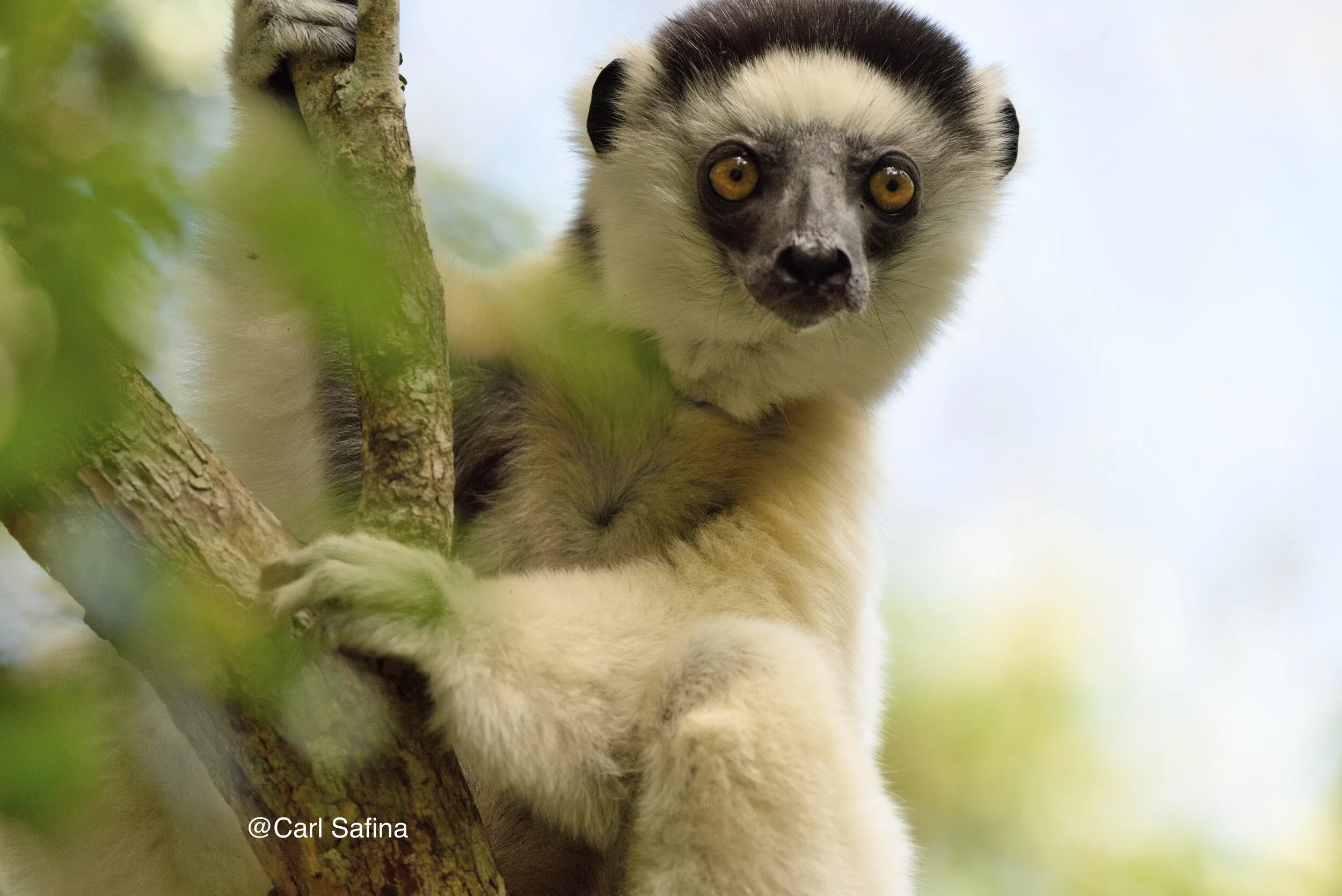Lemurs of Madagascar
On board with Lindblad Expeditions Southern Africa and Indian Ocean tour.
I’d just arrived in Madagascar for the first time. I was with the foremost expert on the primates called lemurs, trying to pay attention. I had everything to learn. We’d just gotten there on the ship National Geographic Orion, courtesy of Lindblad Expeditions.
As soon as we docked in Toliara, people in dugout canoes arrived at our ship seeking to sell us sea turtle shells for one dollar. You start to see right away that the problems are the usual: poverty, ignorance, the need to eat. (We soon met Dr. Garth Cripps who described the innovative programs of Blue Ventures, helping local people set up protected areas on depleted reefs and gain access to family planning.)
We were told that one dollar could buy us a sea turtle’s shell. Photo: Carl Safina
Small mesh nets, designed to catch everything. Photo: Carl Safina
Madagascar, an island the size of California is considered part of Africa. But biologically it’s a tiny continent, isolated since the time of dinosaurs, with many animals and plants found nowhere else. Africa’s famous mammals, for instance—gazelles and elephants and big cats—never made it to Madagascar. Most birds never made it. Humans didn’t get there until about 2,000 years ago. And even they didn’t come from Africa; they were seafarers from what’s now Indonesia.
Lemurs live only on Madagascar. (Say LEE-murz). They evolved there from a pre-monkey, pre-lemur “prosimian” primate ancestor who probably survived a trip across the Mozambique Channel in the hollow of a tree washed out of a river. Because they got there tens of millions of years before rodents, over ages they evolved to exploit all kinds of niches. There are mouse lemurs, squirrel-like lemurs, monkey-like lemurs; there were gorilla-like lemurs until humans arrived and wiped them out. (Humans also killed off Madagascar’s flightless birds, including the world’s heaviest bird, the elephant bird, who weighed eight hundred pounds and stood about ten feet tall until, just 1,000 years ago, the last one fell). There are—and this seems incredible—just over one hundred species of living lemurs! Because they evolved without humans, like birds on oceanic islands, lemurs have no fear of people and have sweet, confiding, mellow personalities.
But lemurs have a problem—guess who.
One of the two-dozen “Sportive” lemur species. Photo: Carl Safina
Madagascar is famous for the fact that people have cut and burned more than 90 percent of the forest. Frankly, I’ve avoided the place for that reason. What I found surprised me greatly. Madagascar has about as many people as California and the population is rapidly rising. I expected throngs of people in very poor villages, the landscape occupied to the horizons with sparse farm plots, cattle herds and goats eating every bush and blade to the ground. (I’d taken what I’ve seen in East Africa and multiplied it in my mind to cover 90 percent of my imagined Madagascar). Instead, Madagascar has vast open areas with few people, goats or cows.
Those wide-open areas seem hard to explain. The people are poor but seem well-fed. Friendly. A visitor feels no resentment or hostility. Between villages there is a lot of room. Ecologically, the tragedy seems that there is simply a culture of burning. People burn land every year or two. Uncontrolled fires sweep wide areas, often engulfing parts of remaining forests. Ostensibly this is to make new grass for cattle. But in fact one sees few cattle out in the open areas. People drive small herds along the roads near villages. Virtually no goats. It’s the burning that creates vast human-made savannahs on a mini-continent where no savannahs existed. So those open grassy areas hold almost no birds or native mammals; certainly no lemurs.
Much of Madagascars former forest areas are open lands, regularly burned. Photo: Carl Safina
Get yourself into any remaining forest or protected area though—there they are! Over the course of several days we visited three protected areas and, with the help of expert local guides, we saw several species of lemurs in each. Along those forest paths we encountered birds and native chameleons and other lizards, and native trees.
The potential for reforestation and recovery is great. But before that could happen, the people with the matches must want to stop setting fires that don’t much help them, and hurt everything else. Patricia Wright, based at her Centre Valbio field station and Stony Brook University, is working hard to find the ways that will succeed.
Verreaux’s Sifaka, Photo: Carl Safina
Ring-tailed Lemurs, Photo: Carl Safina
Coquerele’s Sifaka, Photo: Carl Safina






